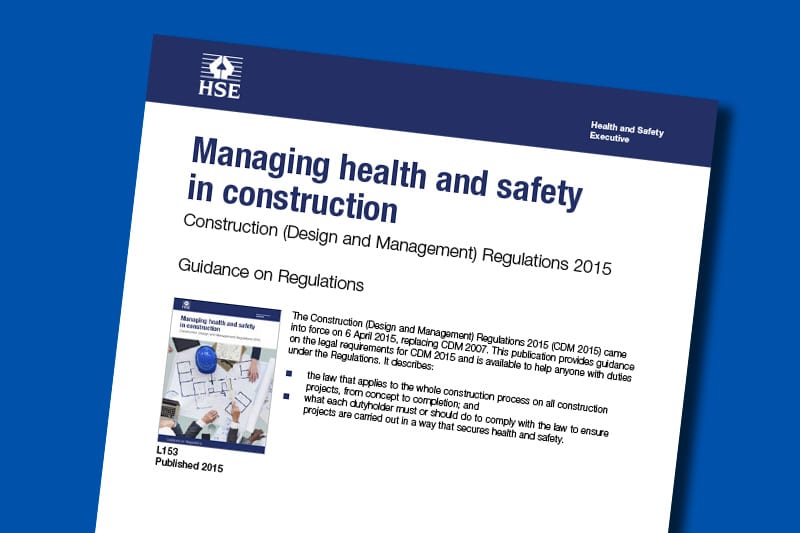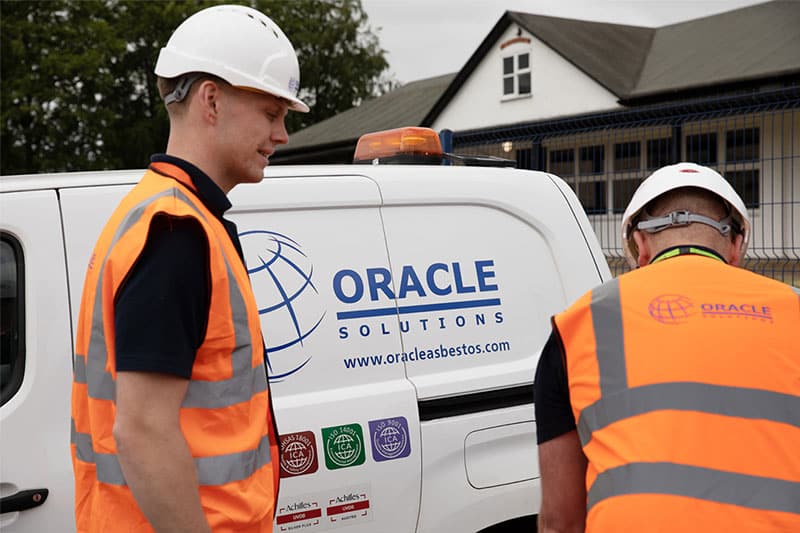What are the current asbestos regulations? Understanding Construction (Design and Management) 2015 (CDM 2015)?
The importance of regulation when it comes to the management of asbestos – especially in relation to construction projects – should never be doubted.
After all, the notorious fibrous silicate mineral – first commercially mined in the middle of the 19th century, and only finally banned in all its forms in the UK in 1999 – is linked to various potentially fatal health conditions among those who swallow or breathe in its fibres. Conditions such as mesothelioma and asbestos-related lung cancer still cause about 5,000 deaths a year in the UK.
Unsurprisingly, then, as public awareness of the pernicious impacts of asbestos exposure on human health has increased through the generations – along with the accompanying political pressure to ban and control the substance – ever-more stringent regulations have been introduced for UK asbestos management.
If you casually mention “the asbestos regulations” to someone who is reasonably knowledgeable about the subject, they might initially presume you are referring to the Control of Asbestos Regulations 2012, or CAR 2012. This legislation provides an overarching regulatory framework for the management of asbestos in non-domestic premises across the UK.
However, the rules contained within the Construction (Design and Management) Regulations 2015, or CDM 2015, must also be carefully considered by anyone involved in a construction project. After all, all manner of typical construction-sector processes, such as renovation or demolition of all or part of a given site, can present a high risk of asbestos-containing materials (ACMs) being disturbed. This, in turn, could cause the release of asbestos fibres and an associated risk to health.
CDM 2015 exists in order to help improve health and safety in the construction industry. These regulations address the management of health, safety, and welfare when construction projects are being undertaken.
However, it might not necessarily be obvious to you what the direct connection is between CDM 2015, and the task of ensuring safe, responsible, and legally compliant asbestos management during a construction project in the UK. So, in this article, we have explored this subject in greater detail.
Key Points
- Comprehensive Duty of Care: CDM 2015 places responsibility on clients, contractors, and designers to manage health and safety risks from the start to the end of construction projects, including the identification and management of asbestos.
- Collaborative Management of Asbestos: The regulations require the principal designer and the client to ensure asbestos exposure is managed, with the principal designer having a pivotal role in providing information on asbestos surveys and management plans to all relevant parties.
- Pre-Construction Planning: Clients must ensure that a construction phase plan is developed prior to commencement, detailing how asbestos will be managed, particularly if it remains in the building post-construction.
- Legal Compliance and Liability: Non-compliance with CDM 2015 regarding asbestos management can lead to criminal offences, including unlimited fines and imprisonment for the principal designer, the principal contractor, and the client.
What is the legislation history and effective date of CDM 2015?
Much of the regulation that now plays such a critical role in keeping UK construction sites safe, was introduced a lot more recently than some casual observers may initially imagine.
Although the Health and Safety at Work Act was passed into law in 1974, it was only at the end of the 1980s that the use of hard hats at construction sites began to be seriously enforced. Other legislative changes down the years, such as the Noise at Work Regulations 1989 and the Personal Protective Equipment at Work Regulations 1992, further helped to make construction sites pleasanter and safer places to be.
In 1994, the first version of the Construction (Design and Management) Regulations was introduced, coming into force in March 1995. These regulations introduced the roles of the planning supervisor and the principal contractor, and marked the first time that clients, designers, and contractors were forced to coordinate their approach to construction-site safety.
The CDM regulations received further major updates in 2007 and 2015. The 2007 version of the regulations replaced the planning supervisor role with that of the CDM coordinator, only for this role to be subsequently removed in the 2015 update. CDM 2015 superseded CDM 2007 from 6th April 2015.
Laws and regulations that more specifically address asbestos have also undergone their own slow, but steady evolution in the UK, from the Asbestos Industry Regulations 1931 and the Asbestos Regulations 1969, right through to CAR 2006 and CAR 2012.
So, when efforts are being made to ensure the highest possible level of safety at a construction site where asbestos is suspected or confirmed to be present, CDM 2015 and CAR 2012 must be considered in conjunction with each other.
Who do the Construction (Design and Management) 2015 regulations apply to?
In the words of the Health and Safety Executive (HSE), “virtually everyone involved in a construction project has legal duties under CDM 2015.”
One of the most distinctive elements of these regulations, is the fact that there are various CDM dutyholders, and a given individual or organisation can be one or more dutyholder for a project.
The list of dutyholders under CDM 2015 can be summarised as follows:
- Clients: the organisations or individuals for whom a construction project is carried out
- Domestic clients: the people who have construction work undertaken on their own home, or the home of a family member that is not done as part of a business, whether for profit or not
- Designers: those who, as part of a business, prepare or modify designs for a building, product, or system related to construction work
- Principal designers: designers appointed by the client in projects where multiple contractors are involved. They can be an organisation or an individual possessing sufficient knowledge, experience, and ability to carry out the role
- Principal contractors: contractors appointed by the client to coordinate a project’s construction phase where multiple contractors are involved
- Contractors: those who carry out the actual construction work, whether as an individual or a company
- Workers: the people who work for or under the control of contractors on a construction site
What is the scope of application for CDM 2015?
All construction work in Great Britain, including domestic projects, is subject to the provisions of CDM 2015. So, if – for example – you are having construction work carried out on your own home, or on the home of a family member that is not done in connection with a business, you will be classed as a domestic client.
Although domestic clients are within CDM 2015’s scope, their duties as a client are usually transferred to the contractor if the project is a single-contractor one, or the principal contractor if the project involves multiple contractors.
Most of the changes made in the most recent version of the CDM regulations do not have a direct impact on the ways in which asbestos is treated in construction projects.
Inevitably, though, there are certain scenarios in which CDM 2015 is particularly relevant when it comes to asbestos management. These include when:
- Maintenance, refurbishment, or demolition activities are being carried out at the given site that may disturb asbestos – and therefore present a risk of asbestos fibres being released
- Work is being carried out to remove or encapsulate ACMs at the premises
If any of these situations apply to you and your construction project in your capacity as a client, dutyholder, or responsible person, and the work is being carried out at a building that was constructed or renovated prior to the year 2000 (in other words, the period when asbestos was in widespread legal use in the UK construction industry), you will need to consider both CDM 2015 and CAR 2012, and take action accordingly to ensure legal compliance.
In the event, for example, that maintenance or refurbishment works are set to take place at your site with the potential consequence of disturbing asbestos, a pre-refurbishment asbestos survey will need to be undertaken before works commence. Alternatively, it might be demolition works that are planned – in which case, it will be a pre-demolition asbestos survey that constitutes an essential process prior to commencement.
If it emerges from the surveying process that asbestos is indeed present on the site, it may be necessary to arrange for asbestos removal or encapsulation works to be carried out. This removal or encapsulation work will need to be followed by asbestos air monitoring, to ascertain that the affected area is safe to be reoccupied.
What are the key provisions related to asbestos under CDM 2015?
The CDM 2015 regulations put in place a responsibility for the client to ensure effective health and safety is planned from the start to the end of the given construction project. This encompasses a need to ensure that potentially hazardous materials and substances – of which asbestos is a great example – are identified and managed appropriately.
It can be easy to be confused by the subject of how asbestos is addressed under CDM 2015, given the potential areas of overlap between this legislation and CAR 2012.
Below, then, we have set out a summary of the asbestos-related provisions contained within CDM 2015:
- There is a shift in responsibilities within the latest CDM regulations, which means the principal designer and the client have a potential duty to ensure asbestos exposure is being managed throughout a construction project
- The HSE’s guidance on CDM 2015 puts in place more explicit requirements on dutyholders to follow the general principles of prevention. Those principles also apply to measures aimed at preventing or minimising the risk of exposure to asbestos fibres
- Where there is a likelihood of planned construction work disturbing asbestos, there is a need for the principal designer – in projects involving multiple contractors – to be given any asbestos survey and other relevant information
- Prior to the construction phase beginning, the client is required to make sure a construction phase plan is in place. Furthermore, where there is a need for licensed asbestos work, it is essential for the licensed asbestos contractor to complete a written plan of work
- If asbestos is to remain in a given building after construction or refurbishment work is completed, this information is required to be kept in the health and safety file
- In the case of a construction project being notifiable, the client now has the duty to inform the HSE
- The principal designer is responsible for supporting the client with the provision of information during a project’s pre-construction, construction, and post-construction phases. The full consideration of asbestos as part of these phases is essential, so that appropriate information can be provided – for example, in relation to existing surveys, existing asbestos management plans, and details of any removals or ongoing management of ACMs, as well as details of how the asbestos management/removal plans have or will be communicated
- There is a need for an asbestos refurbishment survey to be undertaken, of a type which will, under controlled conditions, reveal any potential asbestos materials in the vicinity of the area where works are planned. A visual inspection, or reference to a management survey, is not enough to fulfil the requirement, given that this type of asbestos survey is not intrusive, and has not been carried out to account for any changes to the building.
What are the compliance and enforcement considerations?
Any failure to carry out proper asbestos management during a construction project in the UK – which may or may not entail asbestos being removed from the site altogether – could present a risk of immediate or retrospective liabilities under both CAR 2012 and CDM 2015. This could be the case for the principal designer, the principal contractor, and the client.
It is of the utmost importance that at every stage of a given construction project, the principal designer gives careful thought to asbestos management, and is alert to the risks of failing to do so.
In the event, for example, of any failure to properly control asbestos exposure, this exposure might be deemed to be the principal designer’s responsibility, due to a failure to support the client in the provision of information. In that situation, prosecution could well occur.
Any breach of CDM 2015 is a criminal offence, with wrongdoers potentially risking an unlimited fine and/or imprisonment.
Conclusion: the CDM 2015 regulations have crucial implications for asbestos management
Hopefully, our above words will have given you an appreciation and awareness of how the CDM 2015 regulations relate to asbestos management, particularly when taken into consideration alongside the Control of Asbestos Regulations 2012 (CAR 2012).
Ensuring compliance with the legal requirements in relation to asbestos remains an ongoing challenge in the UK construction industry. So, it is of critical importance for dutyholders under CDM 2015 to be well-informed about – and comply with – the legal obligations that apply to them.
To learn more about our own licensed and accredited asbestos services here at Oracle Solutions, and to request a free and fast quote, please don’t hesitate to contact us.

Written by Jess Scott
Jess Scott has been an all-round asbestos consultant since 1996. That’s nearly 3 decades of asbestos knowledge. He spends his time sharing that knowledge with the team at Oracle and with their clients. Jess's goal is, and always has been, to use my expertise in helping people to comply with the law. This legal compliance ultimately helps to protect everyone from the harmful effects of asbestos. Jess has acted as an asbestos expert witness in legal cases and is involved in many asbestos educational activities throughout the UK.


